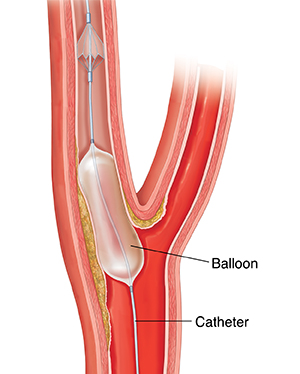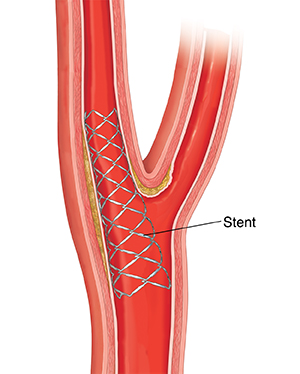Understanding Carotid Angioplasty and Stenting
Angioplasty and stenting is a type of procedure to improve the blood flow in an artery or vein. The carotid arteries are 2 large arteries on either side of your neck. During the procedure, doctors use a thin tube with a balloon at its tip to open up the artery. A tiny metal mesh tube called a stent is put into the artery. It's left in place to help keep the artery open. This is a minimally invasive procedure. That means it’s done with a small incision.
Why is carotid angioplasty and stenting done?
Your carotid arteries send oxygen-rich blood to your neck, face, and brain. A condition called carotid artery stenosis means that 1 of these arteries is narrowed. It can’t send as much blood as it should. Carotid angioplasty and stenting can help reopen this artery. Carotid stenosis is often caused by the buildup of plaque on the inside of the artery. This is known as atherosclerosis. Certain things can raise your risk for carotid stenosis. These include:
-
Smoking.
-
High blood pressure.
-
High cholesterol.
-
Diabetes.
-
Obesity.
-
Aging.
If you have mild carotid artery stenosis, your doctor may give you medicines to reduce your risk for stroke. If you have more severe blockage, your doctor is more likely to advise a procedure to open the artery. Your doctor is also more likely to advise a procedure if you have already had a stroke or ministroke.
Carotid angioplasty and stenting is one choice. Another is a surgery called carotid endarterectomy. This surgery removes plaque and any damaged part of the artery. Carotid angioplasty and stenting is less invasive. That means it uses only a small incision. Because of this, you may recover faster. It also prevents the risks of general anesthesia. Talk with your doctor about the risks and benefits of each procedure for you.
How is carotid angioplasty and stenting done?
The procedure will likely be done by a doctor trained in vascular medicine. They will work with a team of special nurses and technicians. The doctor makes a small cut (incision) in a blood vessel in your groin. They then put a long, thin wire into this cut. The doctor then inserts a thin, flexible tube (catheter) over the wire. It has a tiny, deflated balloon on the end. The doctor threads the catheter up until it gets to the carotid artery in your neck. There, the doctor inflates the balloon inside the narrowed part of the carotid artery. This stretches the area open. You may also get a mesh tube called a stent in the narrowed area. This helps keep the area open.


Risks of carotid angioplasty and stenting
All procedures have risks. The risks of this procedure include:
Your risks may vary based on your overall health, the severity of your condition, and other factors. You may have an increased risk for complications if you:
-
Have symptoms from your carotid stenosis.
-
Have had a stroke or ministroke.
-
Have other health conditions, such as diabetes.
Ask your doctor about which risks apply most to you.